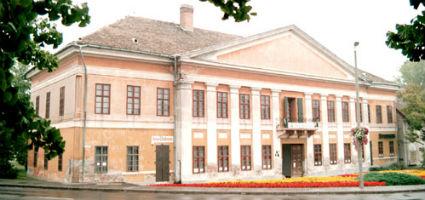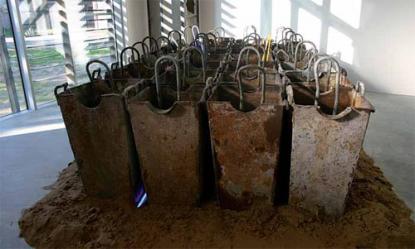2026. January 15. Thursday
Paks Gallery - Paks
 |
Address: 7030, Paks Szent István tér 4.
Phone number: (75) 510-911
E-mail: info@paksikeptar.hu
Opening hours: Winter: Tue 10-16, Wed-Sun 10-17
Summer: Tue 10-16, Wed-Sun 10-18 |
The genealogy of the art of Tamás Trombitás ranges from the Kassák-type picture architecture to the Hungarian geometric neo avant-garde in the 60's. Tamás Trombitás was interested in geometry and its spatial modifications, but without the geometric orthodoxy of the radicals. Simple geometric profiles are in the centre with their spatial and planar relations.

He used a limited amount of means of representation: he put forms into "empty" space; he determined profiles with simple contours still creating a virtual space. From the perspective of painting art, he was "poor". When we study it with rigidity, the conclusion is that he did not do paintings but a spatial system of relations.
He was also interested in neon as a mean of painters and cartographers from the beginning of the 1980's. He did a number of light installations in the second part of the 80's, in natural environment. Neon is mainly used in towns but he made geometric profiles of neon and set it up in forests.
He is allied with post-modern ideas: his serious attachment to the mystic, historic, cultic or symbolic locations. In 1986 he did a light installation in Velem at a Bronze Age archaeological site. Where one the bronze casting workshop stood, he hung up a 2x2-meter neon cube in the forest. Three layers met: real natural environment, civilization originated, technical object, and conscious layers.
The neon statue where the contour of geometric body designates light was one of the most important intersections in his art in the 1990’s. From the second part of the 80’s, his statues are combinations of metal and neon. Spheres, metal, plastic, stone join naturally. They do it the way that we feel that we see Bauhaus with its vibrating games taken to pieces.
This era is closely relate to the constructivist and supremacist premises of art history, but in a more free and emotional state. He often put geometric forms among amorphous metal dust, black foil thus dissolving the rigid unnatural effect of the statues. He kept on adding light via neon to all these.
Péter Fitz

He used a limited amount of means of representation: he put forms into "empty" space; he determined profiles with simple contours still creating a virtual space. From the perspective of painting art, he was "poor". When we study it with rigidity, the conclusion is that he did not do paintings but a spatial system of relations.
He was also interested in neon as a mean of painters and cartographers from the beginning of the 1980's. He did a number of light installations in the second part of the 80's, in natural environment. Neon is mainly used in towns but he made geometric profiles of neon and set it up in forests.
He is allied with post-modern ideas: his serious attachment to the mystic, historic, cultic or symbolic locations. In 1986 he did a light installation in Velem at a Bronze Age archaeological site. Where one the bronze casting workshop stood, he hung up a 2x2-meter neon cube in the forest. Three layers met: real natural environment, civilization originated, technical object, and conscious layers.
The neon statue where the contour of geometric body designates light was one of the most important intersections in his art in the 1990’s. From the second part of the 80’s, his statues are combinations of metal and neon. Spheres, metal, plastic, stone join naturally. They do it the way that we feel that we see Bauhaus with its vibrating games taken to pieces.
This era is closely relate to the constructivist and supremacist premises of art history, but in a more free and emotional state. He often put geometric forms among amorphous metal dust, black foil thus dissolving the rigid unnatural effect of the statues. He kept on adding light via neon to all these.
Péter Fitz
